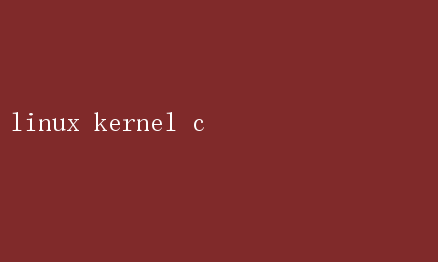
Linux Kernel in C: The Heartbeat of Modern Computing
In the vast landscape of operating systems, one stands out as the bedrock of countless servers, desktops, embedded devices, and even supercomputers: the Linux kernel. Written predominantly in the versatile and powerful programming language C, the Linux kernel is not merely a piece of software; it is a testament to the ingenuity of its creators and contributors, a marvel of open-source collaboration, and the engine driving much of todays technological advancements. This article delves into the intricacies of the Linux kernel in C, exploring its architecture, key components, development process, and the profound impact it has had on the computing world.
The Genesis of Linux
The Linux kernels story begins in 1991, when a Finnish computer science student named Linus Torvalds, frustrated with the limitations and closed nature of MINIX, a Unix-like operating system for academic use, decided to create his own. His initial goal was modest: to develop a free Unix-compatible kernel that could run on his personal computer. Torvalds announced his project on the MINIX newsgroup, inviting others to join him. Little did he know that this modest endeavor would grow into one of the most influential pieces of software in history.
The Architecture of the Linux Kernel
At its core, the Linux kernel is a monolithic kernel, meaning that most of its functionalities are integrated into a single, large executable. This design choice, though debated in favor of more modular approaches like microkernels, has proven highly efficient and scalable, particularly in server environments where performance and reliability are paramount.
The Linux kernel architecture can be broadly divided into several subsystems:
1.Process Management: Handles the creation, scheduling, and termination of processes. The Linux scheduler, a sophisticated piece of software, ensures fair and efficient allocation of CPU time among all running processes.
2.Memory Management: Manages physical and virtual memory, including allocation, deallocation, and protection. The kernel uses virtual memory to provide each process with its own address space, enhancing security and stability.
3.File Systems: Supports a variety of file systems, such as EXT4, XFS, and Btrfs, allowing Linux to run on a wide range of hardware and storage devices. The Virtual File System(VFS) layer abstracts the underlying file systems, enabling interoperability.
4.Network Stack: Implements the network protocols and services necessary for communication over local and wide-area networks. The TCP/IP suite is fully supported, along with other protocols like IPv6 and various network drivers.
5.Device Drivers: Provide an interface between the kernel and hardware devices, enabling the system to interact with peripherals like disks, printers, and network cards.
6.Inter-Process Communication (IPC): Facilitates communication between processes, including pipes, message queues, semaphores, and shared memory.
Writing Kernel Code in C
The choice of C as the primary language for the Linux kernel is not arbitrary. C offers a combination of performance, control over hardware, and portability that is ideal for low-level system programming. Here are some key aspects of writing kernel code in C:
- Kernel Space vs. User Space: Kernel code runs in kernel space, a privileged mode that allows it to perform operations directly on hardware and access sensitive system resources. This separation ensures that user-level applications cannot inadvertently or maliciously disrupt system stability.
- Memory Management: Unlike user-space programs, which rely on the operating system for memory management, kernel code must manage its own memory carefully, avoiding memory leaks and ensuring that allocated memory is freed when no longer needed.
- Concurrency and Synchronization: The kernel must handle multiple tasks and interrupts concurrently. Synchronization mechanisms such as mutexes, spinlocks, and semaphores are crucial to prevent race conditions and ensure data integrity.
- Portability: Although written in C, kernel code is highly dependent on the specific hardware and platform it runs on. Abstractions and macros are used to maintain portability across different architectures.
Key Components and Features
- The Scheduler: The Linux scheduler, based on the Completely Fair Scheduler(CFS), aims to provide fair and efficient CPU allocation. It considers various factors, such as process priority, nice values, and time slices, to ensure responsive and predictable performance.
- The Virtual Memory Manager(VMM): The VMM manages the translation between virtual and physical addresses, supports demand paging, and provides mechanisms for memory protection and isolation.
- The File System Layer: The VFS allows the kernel to support multiple file systems seamlessly. Each file system implements a set of operations that the VFS can call, providing a unified interface to user-space programs.
- Networking: The Linux network stack is robust and feature-rich, supporting a wide range of protocols and devices. It includes layers for link, network, transport, and application protocols, enabling seamless communication across diverse networks.
- Device Drivers: Device drivers are crucial for enabling hardware functionality. They provide an interface between the kernel and hardware, abstracting complex hardware operations into simple, well-defined functions.
The Development Process
The Linux
